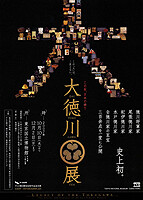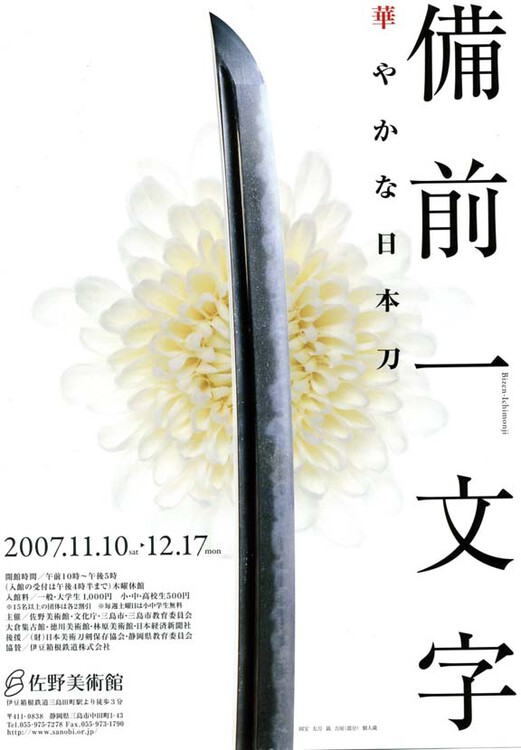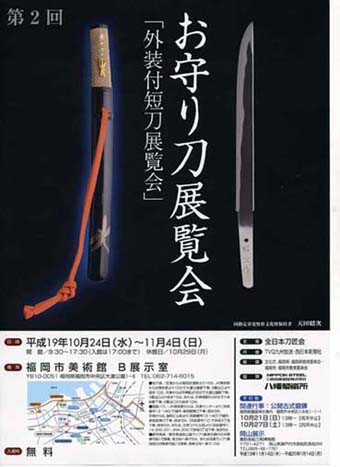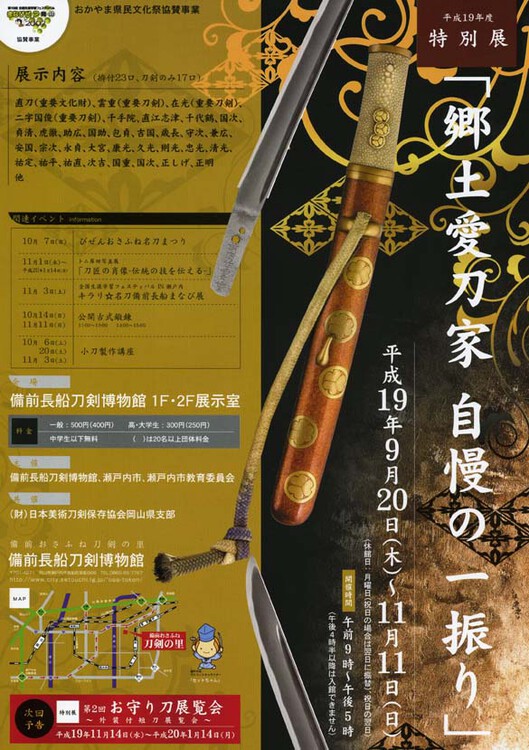-
Posts
212 -
Joined
-
Last visited
-
Days Won
6
Content Type
Profiles
Forums
Events
Store
Downloads
Gallery
Everything posted by Paul Martin
-
Kojima Kunifusa does it have any stamp marks in the blade?
-
Is that a moro-ha zukuri tanto? Can we have better pics please and one of the whole length. A dark background may be better. Sakon Katsumitsu Best
-
Could anyone point me in the direction of the original Japanese sources for the claim that all swords signed Bishu are kazu-uchi mono please?
-
I just wanted to try out the new NMB. Best
-
Kumamoto ken, Amakusa gun Sakase Kawamura 3-800 Mr Ikeda Buntoku/Toyonori Hazarding a guess...
-

Gimei "Rai Kunitoshi" on eBay
Paul Martin replied to Marius's topic in Auctions and Online Sales or Sellers
The pics are not of the best quality, but if you look closely at the nakago omote (katana), you will see that the yasurime between the two ana are not consistent with the rest of the nakago. Also the width of the hi in that area changes. Taking this into consideration, I would say that the mei has been removed and it is trying to pretend to be osuriage. Not uncommon. also both sides are in a similar condition width of the hi etc. The condition of the nakago of a well carried out suriage procedure on top blades is different due to the proper suriage process. Best -
Not any old chokuto mind you, The Shichi Sei Ken that alledgedly belonged to Prince Shotoku Taishi. I hope you all went to the Tokugawa exhibition too! 8 National Treasure blades and 4 juyo bunkazai. Lightings a bit tough, but if you dance around a bit in those crowds you can get by. Takes a bit of determination though. Lovely photos by the way. Best
-
This would have been done in order to adjust the nakago without damaging the inscription. If you look down from above the mune of the nakago, you may notice it taper slightly more on that side. It is an indication of a well carried out machi-okuri/suriage procedure. Best
-
1. The Ichimonji exhibition, soon to open at the Sano Museum. Nov 10-Dec 17 2. The Omamori-gatana exhibition in Fukuoka city museum, Kyushu. A selection of Sacred tanto and koshirae produced by the All Japan Swordsmiths Association. An exhibition of tanto made for spiritual protection, presented to brides, new-born babies and for funeral passages etc. The exhibition will include a display of Tom Kishida's (Yasukuni-to, Modern Japanese Swordsmiths, Craft of the Japanese Sword) photographic works. Oct 24-Nov 4 3. The Bizen, Osafune Japanese Sword Museum is having a special exhibition of Tom Kishida's portraits of swordsmiths entitled 'Tosho Portraits-Passing down traditional skills'. Nov 1 2007-Jan 14 2008
-

Question on Tokubetsu Hozon papers
Paul Martin replied to Martin's topic in General Nihonto Related Discussion
Yes, thats correct, so the cutting edge should be approximately 54.1 cm or 21.2 inches Best -

Question on Tokubetsu Hozon papers
Paul Martin replied to Martin's topic in General Nihonto Related Discussion
Han means half, in this case half a bu, so b -
Hi Carlo, I believe that the future of Stibbert Museum's collection of Japanese swords are in good hands. Riccardo Franci has been making semi-regular trips to Japan to study Japanese swords at the sword museum and with related craftsmen. They have also been conserving some of their works on these occasions too. It looks like they are spending money on the collection a little at a time, but most importantly on the education of their staff, who will undoubtedly in turn educate other members of the Stibbert Museum staff. These things take a little time, but they are on the right road. The future looks bright. Best Paul
-
Hi All, Recently there have been a couple of posts similar to this thread. The first question I find myself asking is "which museum is this?". Museum conservators etc, whilst usually very good at what they do, are not usually knowledgable about nihonto. Nihonto's raw materials and polishing process's are unique to Japan, therefore do not come under the usual rules of conservation of your average museum/art conservator. It is up to us as responsible collectors of Japanese swords to inform other collectors new to nihonto, and museums without nihonto specialists in no uncertain terms that what they are doing is wrong. We do not know the long term effects of wax etc inside scabbards, but it is probably not good, given what we know already. Wax is sticky and likely to get waste particles etc stuck to it. It is also waterproof, so it does not disperse moisture, and could possibly trap it, making things worse. Scabbards that have had wax etc inside them need to be sent to a professional scabbard maker, who will clean the blade and make a new scabbard, and a sunagi for the old koshirae one that is never to be used again, or in the case of an old shirasaya it should be disposed of.
-
A Selection of 100 Meito from the Seikado Museum. Sword data. (Classification by Length) Katana 2 shaku (60.6 cm) and over . Average--2 shaku, 3 sun, 5 bu (71.2 cm) Wakizashi Over 1 shaku (30.3 cm-60.6 cm) but no more than 2 shaku Owakizashi are blades over 1 shaku, 8 sun (54.5 cm). Tanto Blades under 1 shaku (30.3 cm) On average, 8 sun, 5 bu (25,8 cm). Above the average is classed as sunobi, below is called sunzumari. The classification of katana and tachi is not due to length. The katana is where the cutting edge is uppermost when worn through the sash with the makers inscription facing outwards (sashi-omote). When the sword is worn suspended from the sash with the cutting edge towards the ground with the makers inscription facing outwards, this is a tachi. Long tachi etc, of more than 3 shaku (90.9 cm) are referred to as Odachi, whereas small blades (tachi style) under 2 shaku (60.6 cm) are called ko-dachi.
-
There are a couple of other events worth considering, especially if you are travelling around Japan. At Fukuoaka City Museum, Kyushu- The Omamorigatana exhibition. An exhibition of modern tanto and koshirae produced for spiritually protection (weddings new babies etc) by the All Japan Swordsmiths Association. Also, there will be a display of Tom Kishida's photography accompanying the blades at this event. Oct 23- Tom Kishida's work will also be displayed at The Osafune Museum, Okayama in a special exhibition of his work. from the 1st of November 2007-Jan 14 2008 Best
-

Using a nihonto for iaido..
Paul Martin replied to Kevin Adams's topic in General Nihonto Related Discussion
Or a new blade made by a Japanese smith....meeting all the requirements and supporting the craft. Best -
Hi All The other DVD is produced by the All Japan Swordsmiths Association and is called 'Katana--The Spirit and Ancient techniques of the Japanese sword: a modern challenge (or something like that). Then a bunch of fairly well known young smiths (Kubo san, Takami san, Kiyota san, Fujimoto san etc) work us through all of the stages of making a sword whilst trying to create a sue bizen blade at the Osafune Bizen forge in Okayama. In the introduction they show a couple of blades by living nation treasures Amata sensei and Osumi sensei and a Sue Bizen Sukesada whilst giving a general introduction about swords and Bizen den. They come in NTSC or Pal and are 25,000 JPY each Best P
-
Well, I can say something about the Murakumokai dvd as I have the original Japanese version. Eight smiths: Ogawa Kanekuni (Jr) Matsuba Kunimasa Hayasaka Nobumasa Mikami Sadanao (mukansa) Yamamoto Suketada Kubo Yoshihiro Sugita Yoshiaki 25th Fujiwara Kanefusa have formed themselves into the happy band called Murakumokai, and they have a website: http://www.murakumokai.jp/index.htm . Their dvd shows examples of their swords, they or the narrator talk about their styles of work and the dvd also has a section on sword appreciation generally. The quality of the photography is excellent. I have much enjoyed seeing the dvd examples, especially after having seen four of them in the flesh in Paris two years ago together with some of their swords in a small exhibition which Pascal also went to. We wrote up this exhibition for the To-ken Society of Great Britain and this article is on their website: http://www.to-ken.com/articles/Murakumokai.htm together with a few photos. My Japanese being very rudimentary I can grasp that when the narrator or one of the tosho says someone (dot dot dot) "mezashteimasu" that means he is aiming for something, but quite what he is aiming for I currently have to guess, the English translation will be helpful to me at least (and I may even pick up a bit more Japanese if I know what they are saying). I happen to like shinsakuto very much and for me this dvd (in Japanese) is a real visual treat, understanding all of what is being said will make it that much more interesting. The AJSA dvd I don't know, but I'm guessing it's an introduction to the Japanese sword, maybe Paul can add some detail here. Best regards, Dunckx
-
Heads up! The All Japan Swordsmiths Association and the Murakumokai have just reproduced their DVD's in English. Not particularly cheap, but straight from the source. http://www.murakumokai.jp/hd.htm Best P





